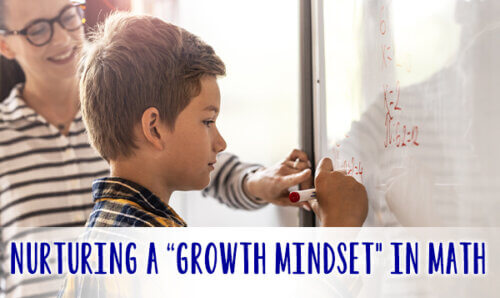By Dallan Hunt
As a math teacher, I always cringe when I hear a parent say they “just aren’t a math person,” or when their child says, “I’m just not good at math.” These sentiments treat math as if it’s a skill you either have or you don’t, stifling any belief in actually improving and growing. This is what we call a Fixed Mindset, in which one believes that the intelligence or talent we are born with doesn’t change. If we fail, it’s because we are a failure, and there’s not much we can do about it. Having a fixed mindset completely stifles your child’s potential to learn math and anything else, which is why at Sylvan we recommend something far better: Growth Mindset.
Growth mindset puts a focus on the process of learning first, and outcome second. This means that whatever strengths and weaknesses we have, we are always asking how we can take the next step forward in order to improve, as long as we are willing to ask for help and work at it. Let’s look at some practical strategies you can use to help your child foster their growth mindset while learning math.
Set Effective Goals
Having the grand and glorious goal of getting an A+ on every math test is not entirely bad, but the problem is this goal doesn’t provide any obvious way of how to achieve it. This would be like aspiring to be an astronaut, without first knowing how to turn on your rocket ship. Effective goals need to help move us forward, and that means they need to be tangible, measurable, and attainable. So, for example, instead of worrying about getting an A+ on your upcoming test, here are more effective goals:
- If learning fraction operations, remember to check if you need a common denominator
- If solving linear equations, remember to check by plugging your answer back into the equation
- For any problem, show your steps and review your solution to check for mistakes
These are examples of goals which actually improve a child’s math, and can be tailored to any topic. Setting small, tangible goals are more effective than simply aspiring for that A+.
Expect Mistakes
One goal or expectation that many math students have, but shouldn’t, is to get the correct answer on the first try. Just try to imagine a world where we solve every problem on our first attempt, in math or anything else. I can’t. But for some reason many math students expect to. This unreasonable expectation sets up students for disappointment, without any benefits. Instead, do the opposite: Do not expect to get the correct answer on the first try.
This might sound pessimistic, but even every Einstein in the world gets wrong answers. Expecting mistakes and errors only shows appreciation for the challenge of learning, which is part of a growth mindset.
Check Over Your Work
If your child appreciates mistakes, there is one inescapable benefit: they’ll also appreciate the value of checking over their work. By expecting mistakes, it’s only natural for students to check over their work, to identify mistakes and make corrective changes. Not only does this make for more correct answers, but is also builds a student’s confidence in their answers. And with more confidence, students are more willing to take on new challenges, and that is definitely a part of the growth mindset.
As a parent, encourage your child by asking them whether their answer is correct, and to explain how they know. This will encourage them to both show their work, and check it over.
Turn Mistakes into Opportunities
Once students acknowledge that mistakes are a part of learning, and they’re willing to check their work to find them, the next step is to turn those mistakes into valuable learning opportunities. Remember: every math mistake is like a signpost, pointing to something your child hasn’t quite mastered yet. Finding mistakes, then, can help your child by pointing out what they don’t yet know.
One way to remember and learn from mistakes is by creating flashcards. When your child identifies a mistake, help them to understand why. Then, turn it into a question to put on one side of the flashcard, and put the answer on the other side. Here is an example:
Suppose your child solves the following problem: 2 x 5 = 7
Here there is confusion between multiplication and addition, so here are some questions which could be put on a flashcard:
- How is addition different from multiplication? Explain with an example.
- How can the following be written as multiplication? 2+2+2+2+2
- Why does 2×5 not equal 7?
Students can build a stack of flashcards which highlight their mistakes, and can then be used for practice and studying before quizzes and tests. By finding mistakes, zooming in on them, and learning from them, it allows your child to advance their knowledge one mistake at a time, which is definitely part of growth mindset.
Overall, having the right mindset is critical for learning math (or anything else!). It’s important to avoid the fixed mindset, which focuses on our limitations to learning. Instead, a growth mindset leads one to always strive to improve themselves, one small step at a time. Some ways to do this are to set effective goals, expect mistakes, check your work, and turn mistakes into learning opportunities. The growth mindset is the way to go!`

